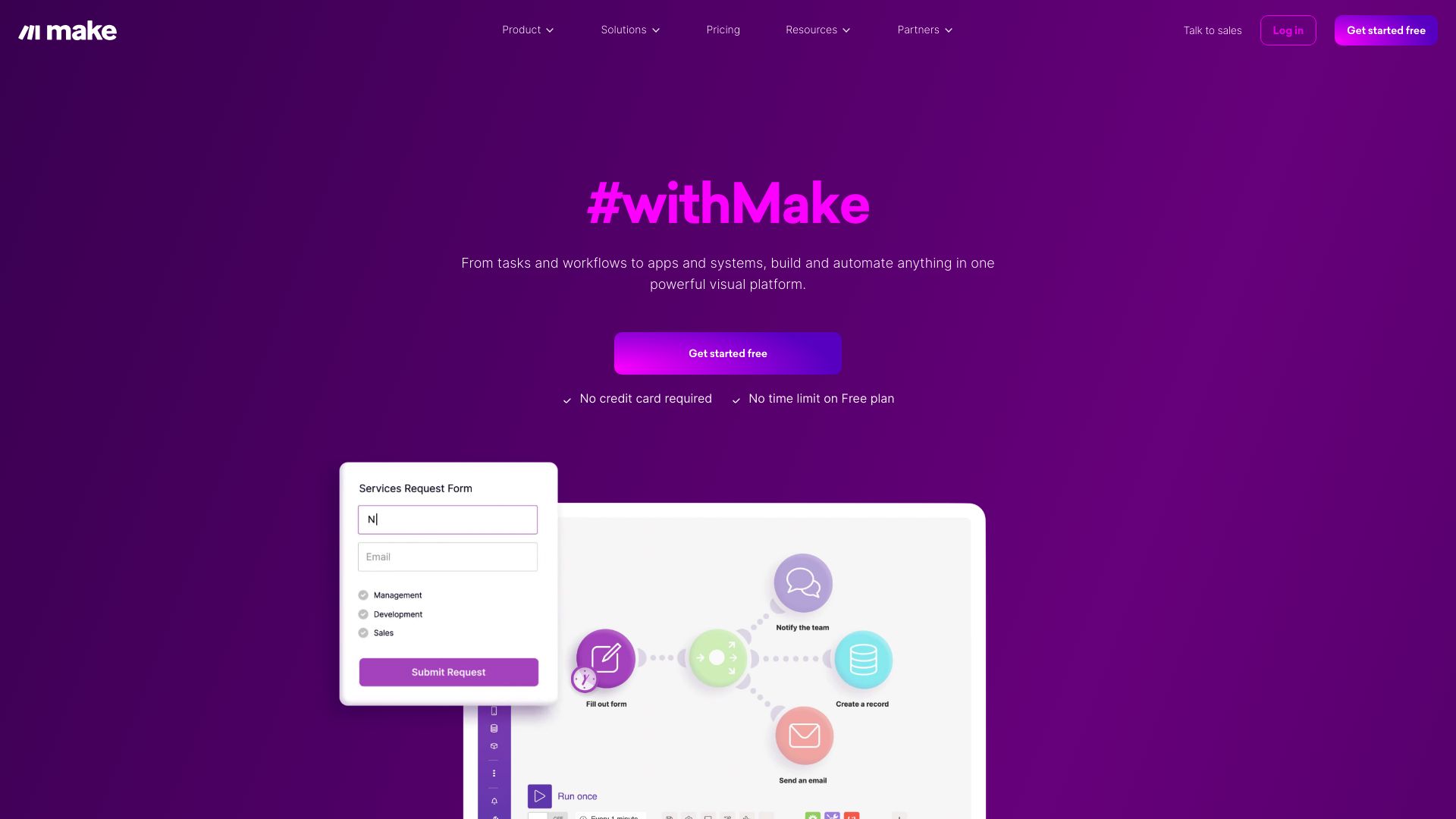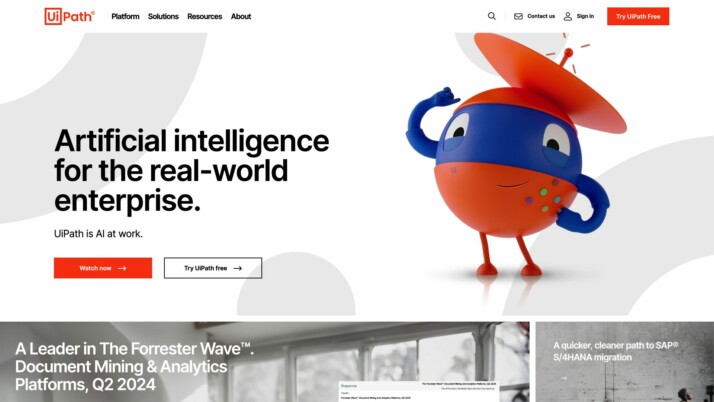AI-driven automation transforms business operations, but choosing the right platform can be challenging. This comparison of Make.com vs. UiPath, and SmythOS reveals key differences in their approaches to workflow automation, robotic process automation (RPA), and AI capabilities.
We explore how Make.com’s visual no-code platform and UiPath’s enterprise-grade RPA stack up against SmythOS’s versatile AI operating system. Discover which solution best fits your organization’s needs for app integration, task automation, and advanced AI functionalities. Whether you’re a developer seeking powerful APIs, a business leader focused on scalability, or a non-technical user looking for accessible tools, this review provides insights to guide your decision-making process.
Make.com Overview
Make.com empowers users to automate workflows and integrate applications without coding. The platform’s visual interface allows drag-and-drop creation of complex scenarios connecting over 1,000 apps and services.


Make.com caters to both technical and non-technical users seeking to streamline business processes. Its no-code approach opens automation possibilities for marketers, sales teams, and operations staff. The platform excels at connecting disparate systems, transforming data, and triggering actions based on schedules or events.
Make.com caters to both technical and non-technical users seeking to streamline business processes. Its no-code approach opens automation possibilities for marketers, sales teams, and operations staff.
Key features include real-time workflow visualization, detailed execution logs for troubleshooting, and scalable plans from personal use to enterprise deployment. Make.com facilitates team collaboration with shared scenarios and granular permissions.
While Make.com offers robust integration capabilities, it lacks some advanced AI functionalities found in dedicated agent builders. The platform focuses on workflow automation rather than autonomous AI agents or natural language processing. This may limit its applicability for complex AI-driven use cases.
Make.com positions itself as a versatile integration platform in a competitive landscape. Its strengths lie in its extensive app connections, visual workflow design, and accessibility to non-developers. However, users requiring deep AI capabilities or highly specialized integrations may need to explore additional tools to complement Make.com’s offerings.
UiPath Overview
UiPath provides a comprehensive enterprise automation platform that enables organizations to discover, build, manage, run, and measure automation across departments. The platform excels at streamlining repetitive tasks and complex workflows, allowing businesses to boost productivity and reduce errors.


UiPath provides a comprehensive enterprise automation platform that enables organizations to discover, build, manage, run, and measure automation across departments.
At its core, UiPath offers robotic process automation (RPA) capabilities, allowing users to create software robots that can mimic human actions. These robots interact with digital systems and software, performing tasks like data entry, document processing, and report generation. UiPath’s visual development environment empowers both technical and non-technical users to design automation workflows without extensive coding knowledge.
UiPath’s platform stands out for its scalability and enterprise-grade features. It supports both attended and unattended automation, making it suitable for front-office tasks requiring human input and back-office processes that can run independently. The platform also provides advanced AI and machine learning capabilities, enabling robots to handle more complex, cognitive tasks like natural language processing and image recognition.
UiPath’s platform stands out for its scalability and enterprise-grade features. It supports both attended and unattended automation…
While UiPath offers powerful automation tools, users should consider the learning curve associated with mastering its full capabilities. The platform’s extensive feature set may require significant time investment for teams to utilize effectively. Additionally, pricing can be a concern for smaller businesses, as UiPath’s enterprise focus often translates to higher costs compared to some alternatives.
UiPath integrates seamlessly with a wide range of enterprise systems and applications, making it a versatile choice for organizations with complex IT environments. Its ability to work across legacy systems and modern cloud-based applications positions it as a valuable tool for digital transformation initiatives. However, users should carefully evaluate their specific needs and resources to ensure UiPath aligns with their automation goals and budget constraints.
Feature Comparison
Make.com and UiPath offer distinct approaches to automation, each with its own strengths and limitations. Make.com provides a visual no-code platform for workflow automation and app integration, while UiPath specializes in robotic process automation (RPA) with AI capabilities.
Make.com excels in its intuitive drag-and-drop interface and extensive app connections, making it accessible for non-technical users to create complex workflows. However, it lacks advanced AI functionalities and autonomous agent capabilities. Make.com’s strength lies in connecting disparate systems and automating data flows, but it falls short in areas like multimodal interactions and AI-driven problem-solving.
UiPath, on the other hand, offers a more comprehensive enterprise automation platform with robust RPA features. It provides tools for both attended and unattended automation, making it suitable for a wider range of use cases. UiPath incorporates AI and machine learning capabilities, enabling more sophisticated cognitive tasks. However, its enterprise focus and complex feature set may present a steeper learning curve and higher costs compared to Make.com.
In contrast, SmythOS bridges the gap between these platforms by offering a versatile AI operating system. We provide advanced AI agent capabilities, including autonomous agents, multi-agent collaboration, and problem-solving abilities. Our platform supports hosted agents for both development and production environments, a feature lacking in both Make.com and UiPath. SmythOS also excels in areas where the other platforms fall short, such as memory and context management, multimodal capabilities, and constrained alignment for ethical AI practices.
SmythOS stands out with its ability to deploy AI agents across various platforms and as different embodiments (API, webhook, scheduled agent, etc.), offering flexibility that surpasses both Make.com and UiPath. We also provide a hosted vector database and support for diverse data sources, enhancing our platform’s data processing capabilities. These features position SmythOS as a more comprehensive solution for organizations seeking to leverage AI in their automation efforts.
Feature Comparison Table
| Make.com | UiPath | SmythOS | |
|---|---|---|---|
| CORE FEATURES | |||
| AI Agents | ❌ | ❌ | ✅ |
| Hosted Agents (Dev, Production) | ❌ | ❌ | ✅ |
| Environments (Dev, Production) | ❌ | ✅ | ✅ |
| No-Code Options | ✅ | ❌ | ✅ |
| Memory & Context | ❌ | ❌ | ✅ |
| Autonomous Agents | ❌ | ❌ | ✅ |
| Explainability & Transparency | ❌ | ❌ | ✅ |
| Multimodal | ❌ | ❌ | ✅ |
| Problem-Solving Capabilities | ❌ | ❌ | ✅ |
| Multi-Agent Collaboration | ❌ | ❌ | ✅ |
| Human-AI Interaction | ❌ | ✅ | ✅ |
| Work as Team | ✅ | ❌ | ✅ |
| SECURITY | |||
| Constrained Alignment | ❌ | ❌ | ✅ |
| Data Encryption | ❌ | ✅ | ✅ |
| IP Control | ❌ | ✅ | ✅ |
| COMPONENTS | |||
| Foundation AIs | ❌ | ❌ | ✅ |
| Huggingface AIs | ❌ | ❌ | ✅ |
| Zapier APIs | ❌ | ❌ | ✅ |
| Classifiers | ❌ | ❌ | ✅ |
| Data Lakes | ❌ | ❌ | ✅ |
| DEPLOYMENT OPTIONS (EMBODIMENTS) | |||
| Deploy as API | ❌ | ❌ | ✅ |
| Deploy as Webhook | ✅ | ❌ | ✅ |
| Staging Domains | ❌ | ❌ | ✅ |
| Production Domains | ❌ | ❌ | ✅ |
| Deploy as Site Chat | ❌ | ❌ | ✅ |
| Deploy as Scheduled Agent | ✅ | ❌ | ✅ |
| Deploy as GPT | ✅ | ❌ | ✅ |
| DATA LAKE SUPPORT | |||
| Hosted Vector Database | ❌ | ❌ | ✅ |
| Sitemap Crawler | ❌ | ❌ | ✅ |
| YouTube Transcript Crawler | ❌ | ❌ | ✅ |
| URL Crawler | ❌ | ❌ | ✅ |
| PDF Support | ❌ | ✅ | ✅ |
| Word File Support | ❌ | ✅ | ✅ |
| TXT File Support | ❌ | ❌ | ✅ |
Best Alternative to Make.com and UiPath
SmythOS emerges as the superior alternative to Make.com and UiPath, offering a comprehensive AI operating system that revolutionizes agent creation and deployment. Our platform bridges the gap between traditional automation tools and advanced AI capabilities, providing users with a powerful yet accessible solution for building intelligent agents.
Unlike Make.com’s limited AI functionalities and UiPath’s complex enterprise focus, SmythOS delivers a versatile platform that caters to both technical and non-technical users. We offer a robust drag-and-drop interface combined with advanced AI agent capabilities, enabling rapid development and deployment of sophisticated AI solutions.
SmythOS emerges as the superior alternative to Make.com and UiPath, offering a comprehensive AI operating system that revolutionizes agent creation and deployment.
SmythOS excels in areas where Make.com and UiPath fall short. Our platform supports autonomous agents, multi-agent collaboration, and AI-driven problem-solving abilities, features absent in both competitors. We provide hosted agents for development and production environments, ensuring seamless scalability and deployment options that surpass the offerings of Make.com and UiPath.
Our commitment to user-friendliness and flexibility sets us apart. SmythOS allows deployment of AI agents across various platforms and as different embodiments (API, webhook, scheduled agent, etc.), offering unparalleled versatility. We also provide a hosted vector database and support for diverse data sources, enhancing our platform’s data processing capabilities. These features position SmythOS as the most comprehensive solution for organizations seeking to leverage AI in their automation efforts, surpassing the limitations of both Make.com and UiPath.
Conclusion
Make.com and UiPath offer powerful automation solutions, each with distinct strengths. Make.com excels in visual workflow design and app integrations, making it accessible for non-technical users. UiPath provides robust RPA capabilities and enterprise-grade features, suitable for complex automation needs. Both platforms deliver value in specific scenarios, but they also have limitations.
SmythOS emerges as a superior alternative, combining the best of both worlds while adding advanced AI capabilities. We offer a versatile AI operating system that goes beyond traditional automation. Our platform supports autonomous agents, multi-agent collaboration, and sophisticated problem-solving abilities. Unlike Make.com and UiPath, SmythOS provides hosted agents for development and production, enhancing flexibility and scalability.
Our solution stands out with features like memory and context management, multimodal capabilities, and constrained alignment for ethical AI practices. SmythOS supports deployment across various platforms and as different embodiments, offering unparalleled versatility. With a hosted vector database and support for diverse data sources, we enable more comprehensive data processing and AI-driven automation.
For organizations seeking to leverage cutting-edge AI in their automation efforts, SmythOS offers a compelling solution. We invite you to explore our diverse range of AI-powered agent templates and experience the future of AI automation. Create a free SmythOS account today and discover how our platform can transform your workflow with intelligent agents, offering a 30-day money-back guarantee. Unlock the power of versatile AI deployment and take your automation capabilities to the next level with SmythOS.